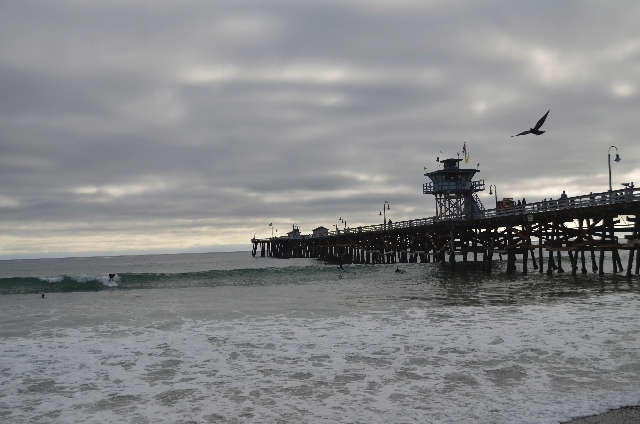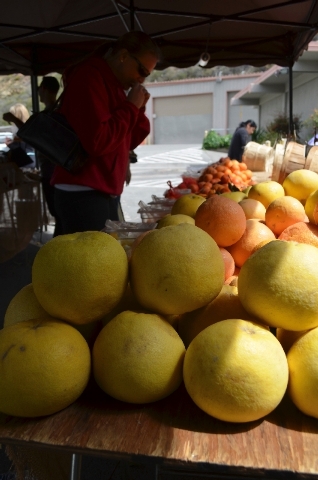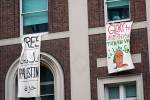Southern California beach towns worthy weekend destinations
A dark object breaks through the sea’s shiny surface and moves across the water. Could be a fin. But it peeks out for just a moment and it’s far off.
Torn between curiosity and concern, I debate whether to investigate, realizing I’m just inches above the water in a plastic kayak. Any closer and I’d be beating my legs in the ocean like the skinny-dipper at the beginning of “Jaws.”
Despite my older sister’s pleas to keep my distance, I paddle forward and bob over the spot where the object poked through, being the 20-something guy that I am.
Small fish have been flicking out of the water, feasting on bugs in the waning afternoon. But this was something big, probably making the fishes’ feeding time its own.
After I spend a few minutes silently scanning near and far, it rises to the surface an arm’s length to my left. And not just a flipper but the entire thing, a full-grown sea lion weighing between 600 and 800 pounds.
It floats on the surface and looks at me while passing by, then dives, providing a fleeting reminder of the ocean’s allure. Nothing else but the sea’s surface tension separates the world we dominate and the wild one beneath. Something could break through at any moment, revealing a flash of what lives in the wide waters below.
Although Las Vegas seems far away this sun-soaked day in Long Beach, Calif., Sin City sits less than five hours from any of Southern California’s beachside communities, making the coast a worthwhile weekend destination. With so many beach towns to choose from, the question is where to go?
To help you decide, we spent a long weekend sampling just about all of them and logging the pros and cons along the 75-mile stretch. From surfing San Clemente to kayaking Naples Canal in Long Beach and walking the famous Santa Monica Pier west of Los Angeles, we tried what each beachside community had to offer (excluding the San Diego area farther south near the Mexican border).
SAMPLING SOUTHERN CALIFORNIA
No matter where you go, here’s the first token of wisdom: Go in the spring or fall.
Every business owner and local said the same, noting the crowds in the restaurants, on the roads, beaches and everywhere else during the summer. It’s to the benefit of your wallet and that of local businesses. To fill the offseason lull, businesses offer cheaper rates on hotels and much else from the fall into May. Year-round, high temperatures reach the 60s at the very least, and a wet suit will keep you plenty warm.
Another note before describing the beach towns themselves. The Southern California coast can be split into two distinct regions.
The southernmost part — spanning from San Clemente to Dana Point and Laguna Beach — consists of picturesque towns set into steep hillsides reaching into the sea. Therefore, they are secluded from the metropolitan areas (and smog) near Los Angeles. These outdoorsy towns pretty much shut down by 10 p.m., so night life is almost nonexistent.
But they offer much in the way of beautiful intimate beaches banked by cliffs, downtowns to stroll through, outdoor activities, restaurants, boating and custom homes that are artwork in and of themselves.
From Huntington Beach to the north, towns become increasingly spread out and flattened, making for wide, straight beaches reminiscent of Florida, and more need for a car. The postcard-perfect resort towns give way to cities.
Offshore oil rigs and onshore oil pumps come into sight. Skies aren’t a pristine blue but become increasingly hazed in smog as Los Angeles nears. However, you have abundant night life and activities in addition to the sea.
SURFING THE SPANISH VILLAGE BY THE SEA
We started farthest south in the cozy town of San Clemente, arriving at noon for our introductory lesson to surfing. The town is known for its 1,300-foot pier and surfing, catching swells all year long, which is why it’s home to many professional surfers and publications such as Surfing Magazine.
Our San Clemente Surf School instructor, Amy, who’s been catching waves here since she left Pennsylvania 17 years ago, took us to T-Street beach. She said less than half of newbies are able to stand on the board in the two-hour lesson costing $90 per person. We beat the statistic and both managed it.
If you’re not into surfing, bodyboarding is much easier, just as fun and cheaper. No lesson needed, just a board rental, usually running about $20 daily. If you don’t need a lesson, surfboards are about $25 per day with wet suits running $15 per day (This goes for all of Southern California, not just San Clemente).
Or just sit back and watch the many skilled surfers ride waves while you dine at The Fisherman’s Restaurant and Bar. Fisherman’s offers a perfect vantage point from atop San Clemente Pier and affordable “sunset dinners.” For $10 to $15, you get an entree, soup or salad, baby red rose potatoes, rice pilaf and fresh vegetables, a sourdough loaf and a scoop of ice cream or sherbet. As you’d expect, fresh local fish is on the menu.
This town is one of the most affordable. We stayed at the Best Western Plus Casablanca Inn — about the only chain hotel in the far-southern towns — for $107 total, the cheapest and nicest of our three hotels in Southern California.
DOING DANA POINT
We woke early Saturday and headed for the Pacific Coast Highway, traveling a short stretch north to Dana Point’s famous harbor, one of the few harbors along the Orange County coast. With migrating gray whales passing through from November to April and blue whales visiting from May to November, there’s no bad time of year for what we were about to do.
Many whale-watching cruise lines are available, but we settled on Capt. Dave’s Dolphin and Whale Safari for $55 per person for 2½ hours. It limits the number of customers per outing so you’re not on a huge, crowded boat but a 50-foot sailable catamaran with a small group.
You can also climb into the catamaran’s twin hulls and look through Plexiglas underwater viewing ports, achieving the same view as if you were swimming along with the dolphins.
The cruise is a great activity for children as well as adults. Better yet, the company offers live video coverage on its website (to rub it in the faces of family and friends who couldn’t make it).
We followed a pod of 30 dolphins for an hour, then found a pair of adult gray whales paralleling the coast on their way north for the summer. The whales ascended for air every few minutes and crested, exposing their knuckly backs. If you’re lucky, they may fluke or put on a show. We also spotted a huge but peculiar fish floating atop the water to sunbathe. The flat “sun fish” weighs 2,200 pounds when fully grown and is an unusual sight with tiny little fins on its pancakelike body.
RELAXING IN LAGUNA BEACH
By 11 a.m., we were in Laguna Beach and headed for the Saturday farmers market (near City Hall), open until noon. Local producers bring in everything from vegetables to jumbo organic strawberries and many varieties of citrus fruit, usually offering free samples.
Before long, we were sitting at the nearby Laguna Culinary Arts for a $5 tasting of eight wines from California, France, Italy, New Zealand, Argentina and Oregon. The deal is available every Saturday from 1 to 4 p.m.
We then walked the town, which Laguna is great for, offering much on Main Street and even more to see along the beaches and bluffs. Almost all businesses offer a handy illustrated map of Laguna as a handy tool to get around.
We didn’t go in the water this day but our hotel, Laguna Beach Inn, offers free beach towels, chairs and umbrellas for day use (in addition to “The Teaching of Buddha” instead of a Bible in the bed stand).
Our favorite part of Laguna — the busiest of the beach communities — was Crescent Bay Marine Sanctuary on the northern end of town. Completely cut off from the other beaches by 50-foot sheer cliffs, this crescent-shaped beach wasn’t crowded by tourists.
It supposedly offers great diving around its shallow rock field and Dead Man’s Reef. I say supposedly because we weren’t able to snorkel Sunday morning because of unusually high waves. It’s said that you can watch the underwater activities of a seal family around Seal Rock.
(Overcast and rougher seas marked every morning of our trip, giving way to clear skies and calmer water by the afternoon. Locals call it morning sickness.)
Since we couldn’t dive, we walked up the steep road to Crescent Bay Point Park, a vista high above the bay, catching sight of two gray whales swimming north.
We then hopped back on the Pacific Coast Highway, passing Newport, Huntington and Seal beaches. From here, the hills flattened and cities sprawled. No more bays and cliffs but wide, straight beaches.
BEACH TOWNS TO SURF CITIES
We stopped at Kayak Rentals in Long Beach’s Alamitos Bay. The price is $9 per hour per person, and they charge for exact time, not rounding your fee to $18 if you’re out one hour and a couple of minutes.
You’re not allowed to venture into the open ocean, but the large marina offers much to see, evident in our 2½-hour outing. You can circle through Naples Canal, which much like the canals in Venice, Italy, is flanked by brilliant architecture.
We saw the most decadent boats of our trip here, but there isn’t much boat traffic, making it ideal for kayaking. You can also paddle up to restaurants along the marina for a bite to eat.
The best part of sea kayaking is that it doesn’t scare off animals the way motorboats do, which is how we got so close to two sea lions.
We stopped at Acapulco Mexican Restaurant y Cantina for a late lunch and mojitos, sitting outside along the canal watching boats come in for the day. A two-item combo with rice and beans cost $10.99.
With the sun falling, we headed for a 104-year-old landmark, the Santa Monica Pier about 30 miles north. We arrived at dusk as the neon Ferris wheel and roller coaster lit up, reflecting bright colors off the cold water. The amusement park on stilts offers many other rides, snack stands and a two-story restaurant, Mariasol, at the end of the pier.
Wanting to stay close to the pier and Santa Monica’s night life, we spent the night at Seaview Hotel just up the hill, being the only midrange hotel near the pier. Amenities are sparse. No ice machine or continental breakfast. The other hotels near the pier are Marriott, Loews and Sheraton.
We woke early the next day to head home, hoping to beat the traffic through Los Angeles. To our benefit, the gridlock was in the other direction.
By noon, we were back in Las Vegas, planning which beachside community we’d stick with next time. But we couldn’t come to a consensus. Each has its draw.
Next time, though, we wouldn’t just scratch the surface. We’d dive in.
Contact reporter Trevon Milliard at tmilliard@review journal.com or 702-383-0279.
IF YOU GO
DIRECTIONS
Las Vegas to San Clemente: Take Interstate 15 south for about 205 miles, exiting onto California Route 91 West toward Beach Cities. After about 9 miles, exit onto California Route 241 South (toll road) toward Irvine. Keep right for California Route 133 South and then follow signs for Interstate 5 South. After about 20 miles on I-5, you’ll take the Ave Palizada exit toward San Clemente.
Northward along coast: From San Clemente, you can either take the scenic route north along the Pacific Coast Highway (California 1) or the San Diego Freeway (Interstate 405), which is usually about 5 miles inland but quicker.
Santa Monica to Las Vegas: Find Interstate 10 East and take it for about 16 miles. Keep right to continue on California Route 60 East. Stay on CA-60 for about 12 miles, exiting onto Interstate 605 North. After 8 miles, exit onto Interstate 210 East. The Interstate turns into California Route 210. Exit onto I-15 North for Las Vegas.
LODGING
Best Western Plus Casablanca Inn: 1601 N. El Camino Real, San Clemente, Calif. Call (949) 361-1644 or visit bwcasablanca.com.
Laguna Beach Inn: 2020 South Coast Highway, Laguna Beach, Calif. Call (949) 494-5450 or visit thelagunabeachinn.com.
Seaview Hotel: 1760 Ocean Ave., Santa Monica, Calif. Call (310) 393-6711 or visit seaviewhotel.com.































